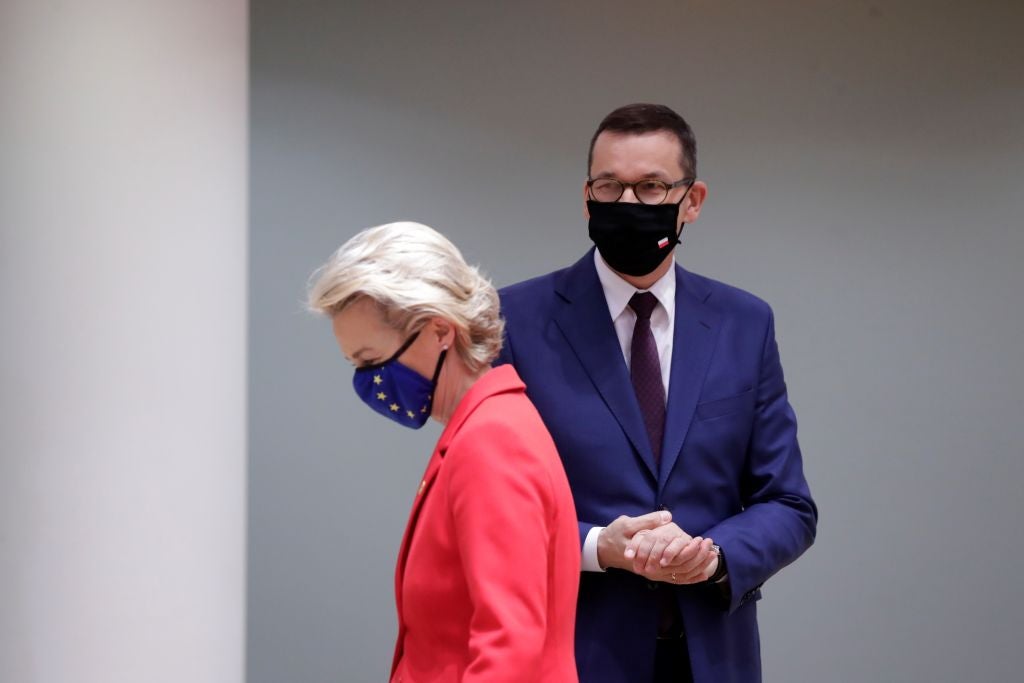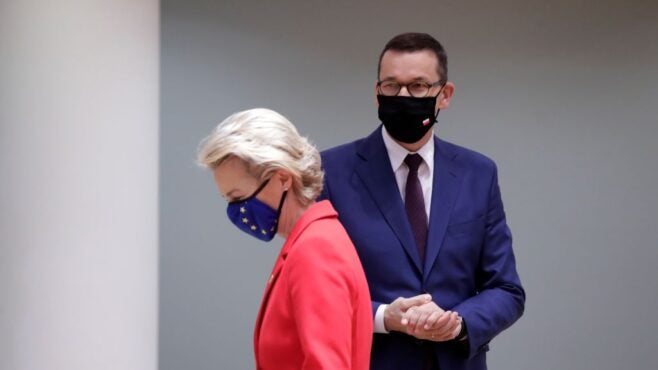
When European Commission President Ursula von der Leyen took to the virtual stage at this weekend’s UN Climate Ambition Summit to mark the one-year anniversary of the Paris Agreement, the EU’s just-agreed, more ambitious climate target for 2030 was the first thing she mentioned.
“55% – that is now indeed Europe’s calling card,” she told delegates. “I am glad the 27 European leaders have signed up to the European Commission’s proposal for taking climate action to a new level of ambition.”

Discover B2B Marketing That Performs
Combine business intelligence and editorial excellence to reach engaged professionals across 36 leading media platforms.
EU national leaders in the European Council had adopted the new target – an increase on the existing target of a 40% emissions reduction from 1990 to 2030 – a day earlier at a meeting in Brussels. Von der Leyen’s eagerness to highlight the Council’s approval of her 55% proposal showed just how important it was that the EU not show up to the international climate summit empty-handed. It also showed why Polish Prime Minister Mateusz Morawiecki was able to pressure the 26 other EU leaders into making concessions in the early hours of Friday morning, after eight hours of overnight negotiations, in order to avoid his veto.

This is far from the first time coal-dependent Poland has wielded a climate veto. The most recent example was in 2019 when Morawiecki refused to sign up to the EU’s target of reducing emissions to net zero by 2050. He then (mis)-spent much political capital removing a provision that would have meant European countries could only access funds from the EU budget if they agreed to the 2050 target – while agreeing to shrink the amount of climate funding available.
Agreeing the 2030 target without Poland again might have been an option, but it would have put an undesirable asterisk on the EU’s commitment to the Paris Agreement the following day.
However, nothing comes for free and Poland inevitably went home with some wins, potentially at the expense of climate action and the EU’s clean energy transition.

US Tariffs are shifting - will you react or anticipate?
Don’t let policy changes catch you off guard. Stay proactive with real-time data and expert analysis.
By GlobalDataNot 60%
First, the obvious. The “at least” 55% 2030 target is not as high as the 65% emissions reduction climate campaigners say is needed to keep global warming below the danger threshold of 2°C above pre-industrial levels or the 60% decrease called for by the European Parliament. Indeed, last week’s deal still needs to be approved by the Parliament for it to become law. A Council source says going higher than Von der Leyen’s proposed 55% was never seriously considered because it would have been a non-starter for Poland and for most eastern European countries.
“Even 55% was a tough battle – it wasn’t only Poland who thought it was too high,” says the Council source. The objections weren’t only in eastern Europe. Von der Leyen’s centre-right European People’s Party gave a less than warm welcome to her proposal, with many in the group preferring a 50% target. Some MEPs were reluctantly won over with the argument that the election of Joe Biden in the US means the EU will not be the only region transitioning away from fossil fuels. China and Japan have also signed up to net-zero targets.
However, even to get 55% passed, some fudging was necessary. Contrary to the previous 40% target, the new one is a ‘net’ target and includes carbon sinks from land use and forestry sectors. The Commission has indicated that if the EU is successful in implementing its biodiversity objectives, carbon removals could represent up to 5% of emissions. In this case the real emissions reduction target would be as low as 50%, says Wendel Trio, director of the non-profit Climate Action Network. “Leaders have agreed to set up emission reduction objectives against nature protection objectives,” he says.
However the leaders did include the words “at least” before 55%. The key here is the “at least” – the 55% is a starting point,” says Sam van den Plas, an analyst with the think tank Carbon Market Watch. “As the EU climate and energy laws are revised from next year, we will need to make sure that they deliver emissions reductions in line with science and fairness.”
But he said there’s no denying the fudge that makes the target weaker than it appears. “Mixing carbon sinks and emission reductions is an irresponsible accounting trick and undermines the deal’s credibility. The point of climate targets is to send a clear signal on the urgency and importance of cutting carbon pollution to avoid a climate breakdown. This must remain separate from protecting forests and land so that they continue to be healthy and absorb and store carbon.”
Another compromise was inserting into the text an explicit mention of nuclear and gas as energy technologies that can be used as part of the energy transition. The text allows for “transitional technologies such as gas.”
The remaining changes were mostly promises that the Commission will look into possibly policy changes next year.
ETS revenue
Ruling out 60%, and fudging on 55%, was done and dusted before last week’s meeting began. What caused the all-night marathon climate negotiations was new last-minute demands from Poland, namely Morawiecki’s request to be allowed to keep more revenue from permit sales in the EU’s Emissions Trading System (ETS). On this he had the support of the Czech Republic and Hungary, but other leaders said this revenue should go to the overall EU budget.
In the end, Poland won a guarantee that the Commission will next year re-examine exactly how ETS funds will be distributed. The Commission will “explore ways to strengthen the ETS system, in particular carbon pricing policies, while preserving its integrity and taking into account the need to address distributional concerns and energy poverty,” state the Council conclusions.
The end result on the role of the EU’s Modernisation Fund, which is funded by auctioning allowances from the ETS, does have potential to do good, says Van den Plas.
“It’s clever to raise revenues from pricing carbon pollution and reinvest these into climate action,” he says. “The EU carbon market’s Modernisation Fund has the potential to do this, but it will need to focus on clean solutions to support a transition to a fully renewable energy future in lower income member states. And let’s not forget that a lot more climate funding will be available to all EU countries when they decide to stop handing out free pollution permits under the carbon pricing scheme.”
Just transition
Poland also won more money for eastern Europe for the just transition, by linking national EU spending targets to GDP. The conclusions task the Commission “to substantially increase the number of allowances dedicated to the Modernisation Fund and the ‘solidarity pool’”, a vehicle set up to support ten lower-income EU countries in their transition to climate neutrality.
Extracting this extra cash didn’t come easily. Western European leaders were annoyed because significant funds had already been made available in the just transition mechanism and the EU’s €1.8trn 2021–27 budget, agreed earlier at the summit. A total of 30% of that budget is ring-fenced for climate.
Eastern European countries wanted explicit mention in the conclusions that upcoming national targets to cut emissions in the sectors not covered by the ETS, such as transport, agriculture and buildings, would be differentiated based on national starting positions and GDP. The conclusions call on the Commission to ensure that the upcoming proposals translating the higher 2030 target into national legislation address “concerns raised in relation to the distribution of efforts, fairness and cost effectiveness, forestry and land use and rising emissions and decreasing sinks from these sectors caused by the adverse effects of climate change.”
That legislation will also make sure that recipients of money from the Modernisation Fund won’t suffer imbalances “in not receiving revenues that are equivalent to the costs paid by the ETS installations in those Member States.”
Delayed decisions
The main way EU leaders solved Poland’s veto threat crisis, though, was by simply delaying decisions until next year. In a last-minute change to their final statement, leaders said they were still debating “the future of the Effort Sharing Regulation”. The European Commission is already considering scrapping or weakening this law, which sets national climate targets and regulates 60% of EU emissions.
The addition of that text has climate campaigners worried.
“Leaders have upped the EU’s ambition, but are they willing to do their fair share at national level?” asks Ellen Valkenborgs, climate manager at campaign group Transport & Environment (T&E). “Without stronger national targets there is little incentive for governments to tax new polluting vehicles and end subsidies for diesel and petrol company cars, measures which are as important as EU CO2 standards.”
Last month, the Commission said it was considering phasing out the effort-sharing law or removing key sectors from the law’s reach, which specifies binding annual emission reduction targets for each EU country to achieve in the road transport, buildings, agriculture and waste sectors.
If governments were no longer required to bring down emissions in road transport and buildings, those sectors would be included in the EU ETS, leaving citizens with higher bills for their road fuel and heating because of higher carbon prices, says T&E. “It is now in EU leaders’ hands to put forward a plan that guarantees minus 55% is delivered,” says Valkenborgs. “Strong national targets need to be part of it. Without making the effort-sharing law more ambitious, governments will put the target just agreed at risk.”
President Von der Leyen was keen to trumpet the newly reduced target at this weekend’s UN summit but, in reality, the last-minute adjustments forced through by Poland mean it is unclear whether this target will really translate to an emissions reduction of 55%. In the short term, it was important for the EU to be able to tell the world it had increased its climate ambition. The hard work of working out the details starts now.





